May Day brought another march for Immigrant Rights, starting at 24th and Mission and going all the way down Mission to 9th before turning towards the Civic Center. I took a bunch of photos which say more than I can say about it. After that I have an excerpt from Peter Linebaugh’s “The Incomplete, True, Authentic and Wonderful History of May Day,” which I performed with LisaRuth both at CounterPULSE on Friday night, and at the Dolores Park anarchist picnic on May Day.
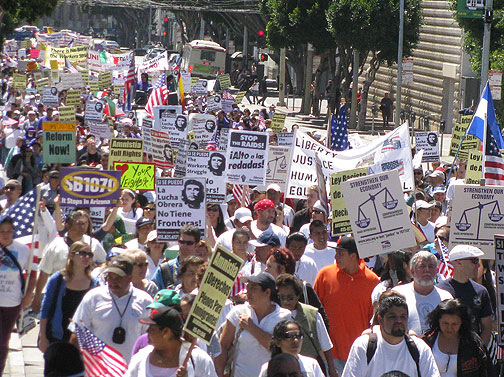
- Several thousand took part.
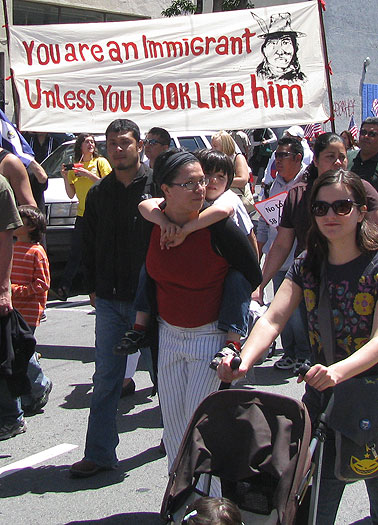
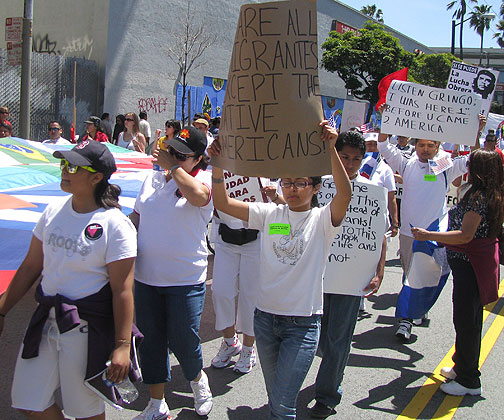
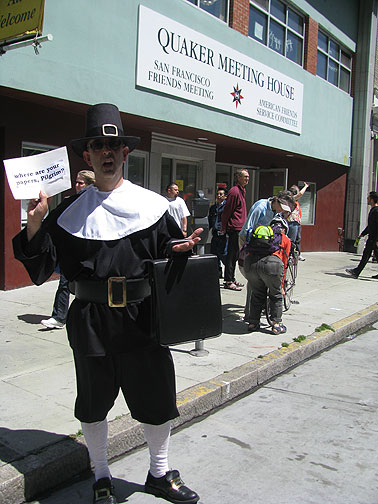
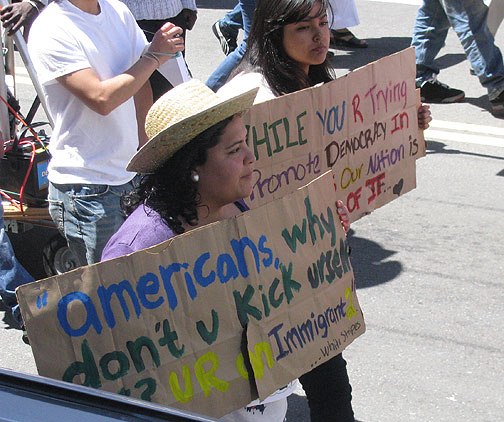
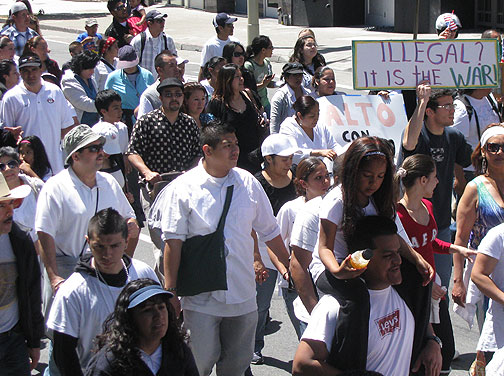
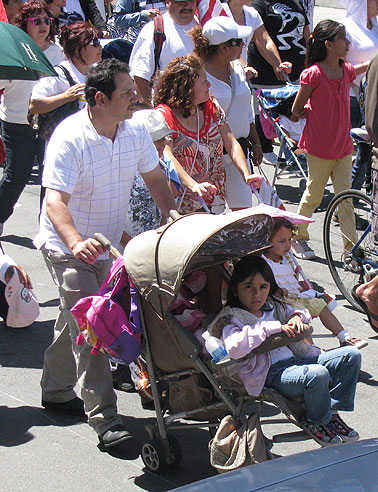
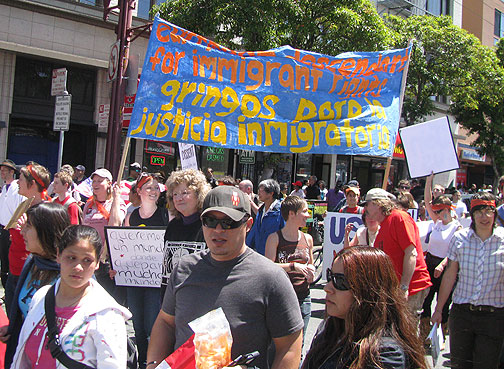
- Later in the afternoon we made it over to Dolores Park where we did our excerpted rendition of Linebaugh’s great text.
- The Incomplete, True, Authentic, and Wonderful History of May Day
- (It’s performed in two voices, one red and one green)
- RED:Â Â Â Â Â Â To the history of May Day there is a Green side and there is a Red side.
GREEN:Â Â Â Â Â Â Green is a relationship to the earth and what grows therefrom.
RED:Â Â Â Â Â Â Red is a relationship to other people and the blood spilt there among.
GREEN:Â Â Â Â Â Â Green designates life with only necessary labor;
RED:Â Â Â Â Â Â Red refuses death by surplus labor.
GREEN:Â Â Â Â Â Â Green is natural appropriation;
RED:Â Â Â Â Â Â Red is war against social expropriation.
GREEN:Â Â Â Â Â Â Green is social utility;
RED:Â Â Â Â Â Â Red resists manufactured futility.
GREEN:Â Â Â Â Â Â Green dreams of the world that is to come;
RED:Â Â Â Â Â Â Red resists the world as it is.
GREEN:Â Â Â Â Â Â Green is nurturance;
RED:Â Â Â Â Â Â Red is struggle.
BOTH:Â Â Â Â Â Â May Day is both. - GREEN: Once upon a time, long before President Obama was born, long before the 21st century, the earth was blanketed by a broad mantle of forests. As late at Caesar’s time a person might travel through the woods for two months without gaining an unobstructed view of the sky. The immense forests of Europe, Asia, Africa, and America provided the atmosphere with oxygen and the earth with nutrients. Within the woodland ecology our ancestors did not have to work the graveyard shift, or to deal with flextime, or work from Nine to Five. Indeed, the native Americans whom Captain John Smith encountered in 1606 only worked a few hours a week. The origin of May Day is to be found in the Woodland Epoch of history.
In Europe, as in Africa, people honored the woods in many ways. With the leafing of the trees in spring, people celebrated “the fructifying spirit of vegetation.” They did this in May, a month named after Maia, the mother of all the gods according to the ancient Greeks, giving birth even to Zeus.
The Greeks had their sacred groves, the Druids their oak worship, the Romans had their games in honor of Floralia. In Scotland the herdsmen formed circles and danced around fires. The Celts lit bonfires in hilltops to honor their god, Beltane. In the Tyrol people let their dogs bark and made music with pots and pans. In Scandinavia fires were lit and the witches came out.
Everywhere people “went a-Maying” by going into the woods and bringing back leaf, bough, and blossom to decorate their persons, homes, and loved ones with green garlands. Outside theater was performed with characters like “Jack-in-the-Green” and “Queen of the May.” Trees were planted. Maypoles were erected. Dances were danced. Music was played. Drinks were drunk, and love was made. Winter was over, spring had sprung.
- RED: The history of these customs is complex and affords the student of the past with many interesting insights into the history of religion, gender, reproduction, and village ecology. The farmers, workers, and child-bearers (laborers) of the Middle Ages had hundreds of holydays which preserved the May Green, despite the attack on peasants and witches. Despite the complexities, whether May Day was observed by sacred or profane ritual, by pagan or Christian, by magic or not, by straights or gays, by gentle or calloused hands, it was always a celebration of all that is free and life-giving in the world.
-
GREEN: That is the Green side of the story.
RED: WHATEVER ELSE IT WAS. . .
BOTH: IT WAS NOT A TIME TO WORK.
GREEN: Therefore, it was attacked by the authorities. The repression had begun with the burning of women and it continued in the 16th century when America was “discovered,” the slave trade was begun, and nation-states and capitalism was formed. In 1550 an Act of Parliament demanded that Maypoles be destroyed, and it outlawed games. In 1644 the Puritans in England abolished May Day altogether. To these work-ethicists the festival was obnoxious for paganism and worldliness.
RED: The people resisted the repressions. Thenceforth, they called their May sports, the “Robin Hood Games.” Capering about with sprigs of hawthorn in their hair and bells jangling from their knees, the ancient characters of May were transformed into an outlaw community, Maid Marions and Little Johns. The May feast was presided over by the “Lord of Misrule,” “The King of Unreason,” or the “Abbot of Inobedience.” Washington Irving was later to write that the feeling for May “has become chilled by habits of gain and traffic.” As the gainers and traffickers sought to impose the regimen of monotonous work, the people responded to preserve their holyday.
GREEN: Thus began in earnest the Red side of the story of May Day.
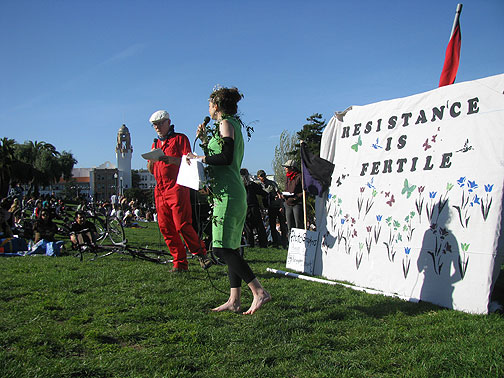
- RED: In England the attacks on May Day were a necessary part of the wearisome, unending attempts to establish industrial work discipline. The attempt was led by the Puritans with their belief that toil was godly and less toil wicked. Absolute surplus value could be increased only by increasing the hours of labor and abolishing holydays. A parson wrote a piece of work propaganda called Funebria Florae, or the Downfall of the May Games. He attacked, “ignorants, atheists, papists, drunkards, swearers, swashbucklers, maid-marians, morrice-dancers, maskers, mummers, Maypole stealers, health-drinkers, together with a rapscallion rout of fiddlers, fools fighters, gamesters, lewd-women, light-women, affronters of ministry, misspenders of time, and abusers of the creature, &c.”
GREEN: Chimney sweeps and dairy maids led the resistance. The sweeps dressed up as women on May Day, or put on aristocratic perriwigs. They sang songs and collected money. When the Earl of Bute in 1763 refused to pay, the opprobrium was so great that he was forced to resign. Milk maids used to go a-Maying by dressing in floral garlands, dancing, and getting the dairymen to distribute their milk-yield freely. Soot and milk workers thus helped to retain the holyday right into the industrial revolution.
RED: On May Day 1830, a founder of the Knights of Labor, the United Mine Workers of America, and the Wobblies was born in Ireland, Mary Harris Jones, a.k.a. “Mother Jones.” She was a Maia of the American working class.
The history of modern May Day originates in the center of the Nort-+h American plains, at Haymarket, in Chicago” “the city on the make”” in May 1886. The Red side of that story is more well-known than the Green, because it was bloody.
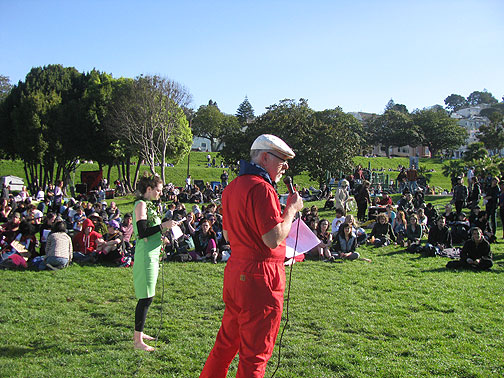
- GREEN: But there was also a Green side to the tale, though the green was not so much that of pretty grass garlands, as it was of greenbacks, for in Chicago, it was said, the dollar is king.
Of course the prairies are green in May. Virgin soil, dark, brown, crumbling, shot with fine black sand, it was the produce of thousands of years of humus and organic decomposition. For many centuries this earth was husbanded by the native Americans of the plains.
RED: Then the land was mechanized. Relative surplus value could only be obtained by reducing the price of food. The proteins and vitamins of this fertile earth spread through the whole world. Cyrus McCormick’s mechanical reapers harvested the grasses and grains. Not that McCormick actually made reapers, members of the Molders Union Local 23 did that, and on May Day 1867 they went on strike.
A staggering transformation was wrought. It was “Farewell” to the hammer and sickle. “Goodbye” to the cradle scythe. “So long” to Emerson’s man with the hoe. These now became the artifacts of nostalgia and romance.
GREEN: It became: “Hello” to the hobo, “move on” to the harvest stiffs, “line up” to the proletarians. Such were the new commands of civilization.
RED: McCormick cut wages 15%. His profit was 71%. In May 1886, four molders whom McCormick locked out were shot dead by the police. Thus, did this “grim reaper” maintain his profits.
On May 4, 1886 several thousand people gathered near Haymarket Square to hear what August Spies, a newspaperman, had to say about the shootings at the McCormick works. Albert Parsons, a typographer and labor leader spoke next. Later, at his trial, he said, “What is Socialism or Anarchism? Briefly stated it is the right of toilers to the free and equal use of the tools of production and the right of the producers to their product.” When 176 policemen charged the crowd, an unknown hand threw a stick of dynamite, the first time that Alfred Nobel’s invention was used in class battle.
All hell broke loose, many were killed, and the rest is history.
Eight men were railroaded in Chicago at a farcical trial. Four men hanged on “Black Friday,” November 11, 1887.
“There will come a time when our silence will be more powerful than the voices you strangle today,” said Spies before he choked.
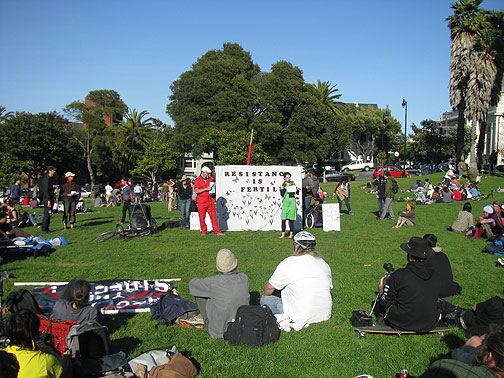
- GREEN: Lucy Parsons, widowed by Chicago’s “just-us,” set out to tell the world the true story of Albert, “of one whose only crime was that he lived in advance of his time.” She went to England and encouraged English workers to make May Day an international holiday for shortening the hours of work.
Her work was not in vain. May Day, or “The Day of the Chicago Martyrs” as it is still called in Mexico, “belongs to the working class and is dedicated to the revolution,” as Eugene Debs put it in his May Day editorial of 1907. The A.F. of L. declared it a holiday. Both the Knights of Labor and the Second International officially adopted the day.
RED: Bismarck, on the other hand, outlawed May Day. President Grover Cleveland announced that the first Monday in September would be Labor Day in America, as he tried to divide the international working class.
The Russian Revolution of 1905 began on May Day. With the success of the 1917 Bolshevik Revolution the Red side of May Day became scarlet, crimson, for ten million people were slaughtered in World War I. The end of the war brought work stoppages, general strikes, and insurrections all over the world, from Mexico to Kenya, from China to France.
GREEN:   1968 was a good year for May Day. Allen Ginsberg was made the “Lord of Misrule” in Prague before the Russians got there. In Mississippi could not prevent 350 black students from supporting their jailed friends. At Columbia University thousands of students petitioned against armed police on campus. The climax to May 1968 was reached in France where there was a gigantic General Strike under strange slogans such as “Parlez à vos voisins!” (Talk to your neighbors), “L’imagination prend le pouvoir!” (All power to the imagination!), “Dessous le pavés c’est la plage!” (Beneath the pavement, the beach!).
RED: In San Francisco, hundreds of May Day anti-war protesters stopped business as usual in the Financial District on May 5, 1971, as spontaneous marches were met with police attacks on California, Bush and Sansome streets, hospitalizing over 60 protesters.
GREEN: On May Day 1980, the Green and Red themes were combined when a former Buick automaker from Detroit, one “Mr. Toad,” sat at a picnic table and penned the following lines:
RED: The eight hour day is not enough;
We are thinking of more and better stuff.
So here is our prayer and here is our plan,
We want what we want and we’ll take what we can.GREEN:Â Â Â Down with wars both small and large,
Except for the ones where we’re in charge:
Those are the wars of class against class,
Where we get a chance to kick some ass.RED:Â Â Â For air to breathe and water to drink,
And no more poison from the kitchen sink,
For land that’s green and life that’s saved
And less and less of the earth that’s paved.GREEN:Â Â Â No more women who are less than free,
Or men who cannot learn to see
Their power steals their humanity
And makes us all less than we can be.RED:Â Â Â For teachers who learn and students who teach
And schools that are kept beyond the reach
Of provosts and deans and chancellors and such
And Xerox and Kodak and Shell, Royal Dutch.GREEN:Â Â Â An end to shops that are dark and dingy,
An end to Bosses whether good or stingy,
And end to work that produces junk,
An end to junk that produces work,
And an end to all in charge” the jerks.RED:Â Â Â For all who dance and sing, loud cheers,
To the prophets of doom we send some jeers,
To our friends and lovers we give free beers,
And to all who are here, a day without fears.GREEN:Â Â Â So, on this first of May we all should say
That we will either make it or break it.
Or, to put this thought another way,BOTH: Let’s take it easy, but let’s take it.

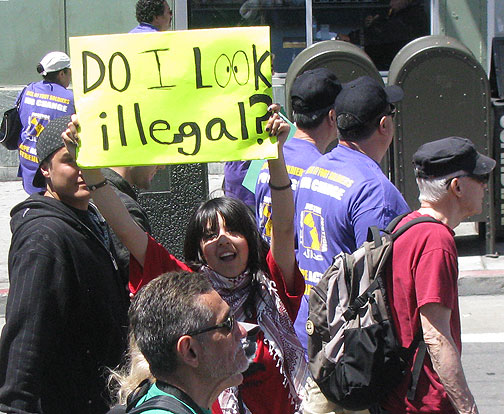
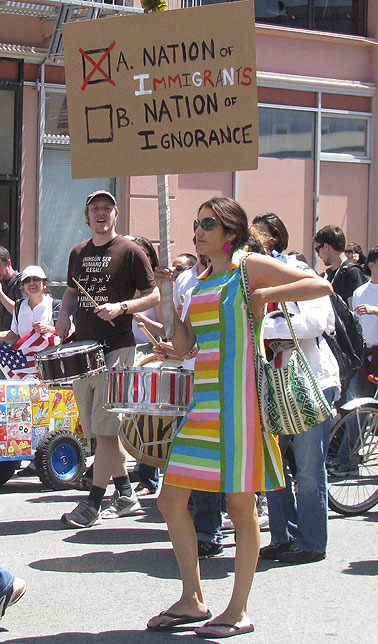
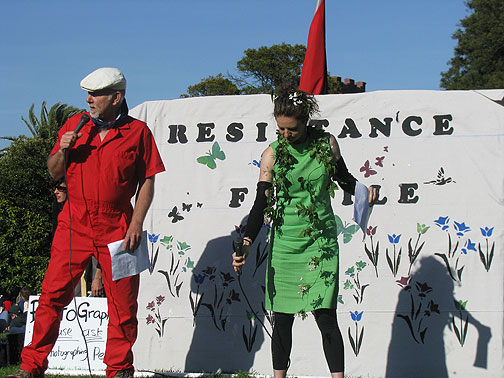











Leave a Reply